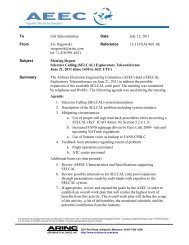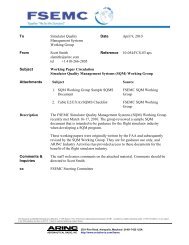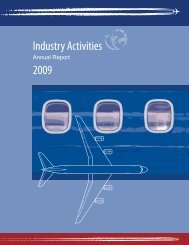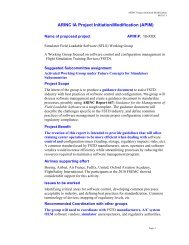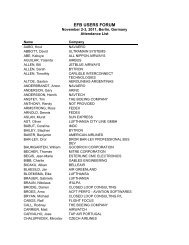(AGIE) Using Internet Protocols - Aviation Committees - AEEC - AMC
(AGIE) Using Internet Protocols - Aviation Committees - AEEC - AMC
(AGIE) Using Internet Protocols - Aviation Committees - AEEC - AMC
- No tags were found...
You also want an ePaper? Increase the reach of your titles
YUMPU automatically turns print PDFs into web optimized ePapers that Google loves.
2.0 <strong>AGIE</strong> PURPOSE AND OBJECTIVESARINC PROJECT PAPER 830 – Page 52.0 <strong>AGIE</strong> PURPOSE AND OBJECTIVESThe intention of ARINC Project Paper 830: Aircraft/Ground Information Exchange(<strong>AGIE</strong>) is to establish a standard for a non-proprietary application level informationinterchange framework. This includes protocols, functions, and interfaces thatenable application-to-application information exchange between aircraft and groundapplications in a universal manner. While at the <strong>AGIE</strong> layer all communicationsoccur over IP, the standard does not stipulate lower layer communicationtechnologies.The aviation industry has spent significant effort defining numerous, independentand often competing technologies and communication protocols to support thedelivery of aircraft information. With the introduction of these technologies toaviation comes the need to assure efficient, interoperable and secure informationinterchange between various systems and respective software applications suchthat airlines, airframe manufacturers, third-party content providers, and <strong>Internet</strong>data-link service providers may rely on this type of data exchange infrastructure.This information interchange capability needs to be based on an always available,common, and non-proprietary information exchange framework. Moreover, thisframework needs to coordinate and centrally manage cost, performance and qualityof service, and reduce the operator’s footprint in applications associated serverequipment.Examples of systems that are in need of such an infrastructure include: DataLoading Systems, Electronic Flight Bags (EFB), In-Flight Entertainment (IFE), FlightOperations Quality Assurance (FOQA), and IP enabled avionics and cabin systems.Other emerging capabilities driven from regulatory community include: FAA AircraftAccess to SWIM and RTCA SC-206 weather and aviation information.2.1 Objectives<strong>AGIE</strong> brings several diverse concepts to bear on messaging and data exchange.<strong>AGIE</strong> goals include supporting cross domain services. These services support theAircraft Control Domain (ACD), Airline Information Services Domain (AIS) andPassenger Information and Entertainment (PIES) Domain. These domains aredefined in ARINC Specification 664 Part 5: Network Domain Characteristics andInterconnection. <strong>AGIE</strong> intentionally excludes the Passenger Operated DevicesDomain (PODS). This goal is accomplished by providing features and capabilitiesthat allow operation across and segregation between these three domains.An additional important goal is for <strong>AGIE</strong> to be link agnostic. While <strong>AGIE</strong> is definedfor <strong>Internet</strong> Protocol (IP) links, it is intended to function over any air-to-ground link.<strong>AGIE</strong> shares these links with other services which may in fact be within any of thefour domains (in this context <strong>AGIE</strong> also interacts with PODS).While this Specification is designed to support these goals, it does not guaranteethat any specific implementation or set of overriding applications will in the end beapprovable. A careful security and safety analysis in implementation is required.<strong>AGIE</strong>’s end-to-end capability is unique (compared to other aviation standards) inthat most aviation standards apply to either the air or ground side or to a (rather)narrow air-to-ground segment. <strong>AGIE</strong> is truly end-to-end. Not only does <strong>AGIE</strong> specifyair and ground aspects, but also client-to-client and application-to-application.Another key <strong>AGIE</strong> goal is to provide mechanisms that allow the operator to managedatalink cost, performance and QoS. <strong>AGIE</strong> provides operator prioritization and



